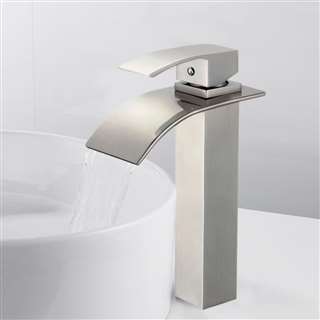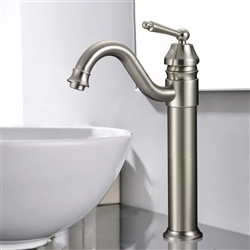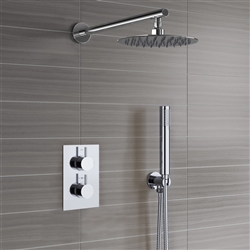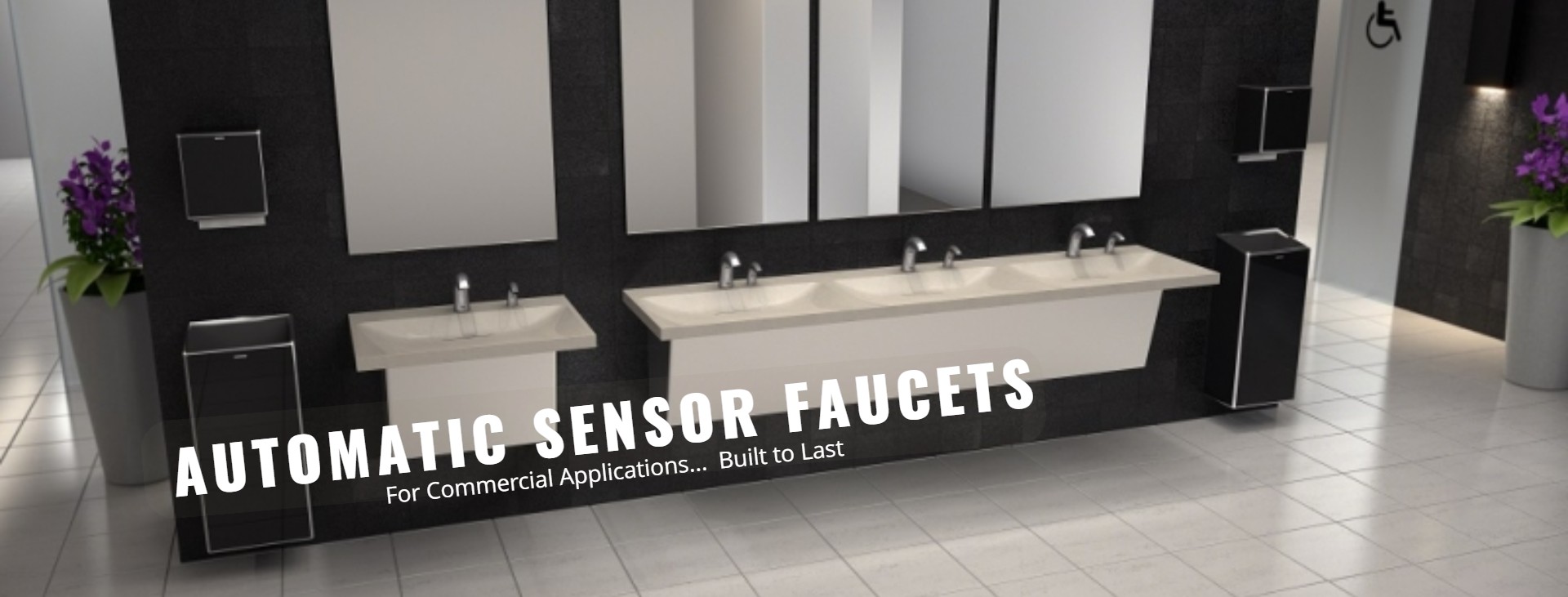Brass Faucets vs Stainless Steel Faucets – Advantages and Disadvantages
Brass Faucets vs Stainless Steel Faucets vs Chrome Faucets – Advantages and Disadvantages
![]()
Choosing a bathroom faucet finish often stumps many people that’s a normal thing. So what’s the difference between brass faucets stainless steel or chrome? and what are the advantages of brass versus stainless steel? Fear not. We have this article dedicated to the advantages and disadvantages of brass faucets vs stainless steel faucets vs chrome.
Brass is generally softer and more susceptible to scratches and dents
Stainless Steel has a heat resistant property that – iron based alloy- is considered corrosion resistant, tarnish resistant , and simply will not rust!
![]()
Brass fixtures tend to be more expensive than stainless steel fixtures
Brass and stainless steel are two common materials used for bathroom fixtures, and they have key differences. Here is major breakdown of the dissimilarities between the brass and stainless steel bathroom fixtures:
- The brass is an alloy primarily composed of copper and zinc, while stainless steel is an alloy of iron, chromium, and often other elements like nickel or molybdenum. The presence of different elements gives them distinct properties.
- The brass fixtures have a warm, golden hue due to the copper content. Over time, they develop a natural patina that adds character. On the other hand, the stainless steel has a silver or brushed silver appearance, providing a modern and sleek look.
- Both the brass and stainless steel are highly durable materials, but they have different strengths. Brass is generally softer and more susceptible to scratches and dents. Stainless steel, on the other hand, is extremely resistant to corrosion, stains, and scratches, making it a durable choice.
- Brass fixtures require regular maintenance to prevent tarnishing and maintain their shine. They may need occasional polishing to remove tarnish and restore their original luster. Stainless steel fixtures, however, require minimal maintenance as they are resistant to tarnishing and corrosion.
Stainless steel is extremely resistant to corrosion, stains, and scratches, making it a durable choice
Brass fixtures tend to be more expensive than stainless steel fixtures. The cost difference is primarily due to the higher price of copper, which is a significant component of brass alloys.
Brass fixtures are often associated with a more traditional or vintage style, adding warmth and richness to the bathroom design. Stainless steel fixtures, on the other hand, have a contemporary and sleek appearance that complements modern or minimalist design styles.
Chrome vs Stainless Steel
Stainless Steel Faucets tend to be less maintenance compared to chrome faucet since the stainless steel is scratch resistant and will disguise spots and smudges.
If you’re new to selecting finishes, it’s really a good idea to get all the other fixtures and accessories in a matching color or at least in harmony. Some finishes are a standard color, such as chrome and most brushed-nickel finishes, but not all finishes from different companies will always look the same.
In selecting bathroom fixtures whether for your house or for a commercial bathroom setting there are always factors that determine what material works best. Would be chrome vs stainless steel based on finish, durability or application. You may consider brass faucets or stainless steel, in doing so you need to consider several factors including the level of humidity, heat, water and other environmental settings that take a toll on your hardware and aesthetic touches.
When comparing the resistance to scratches and long-term wear and tear, stainless steel generally offers superior durability compared to chrome. Stainless steel is highly resistant to scratches, corrosion, and tarnishing due to its composition, which includes a minimum of 10.5% chromium. This makes it a durable and long-lasting choice for fixtures that are exposed to moisture and frequent use. On the other hand, while chrome finishes can provide a sleek and shiny appearance, they are more susceptible to scratches and can show signs of wear over time. Regular maintenance and gentle cleaning are important for both finishes to ensure their longevity, but stainless steel tends to withstand the rigors of daily use and maintain its aesthetic appeal better than chrome.
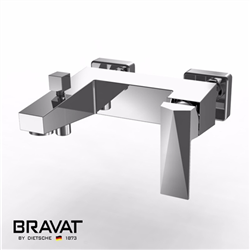 Bravat Bathtub Wall Mount Faucet
Bravat Bathtub Wall Mount Faucet
This contemporary bathtub and shower faucet first catches the eye with straight geometric lines and unique design. The high-quality chrome finish stands for the best performance and long-lasting lifetime of the faucet. It comes complete with accessories and installation instructions
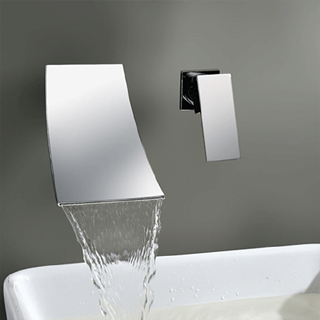 Wall mount waterfall Sink faucets bathroom with an elegant chrome finish
Wall mount waterfall Sink faucets bathroom with an elegant chrome finish
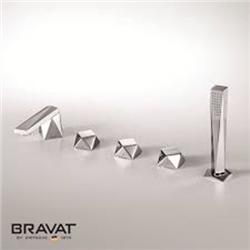 Bravat Bathtub Shower Faucet
Bravat Bathtub Shower Faucet
No one can resist the temptation to buy this fantastic shower faucet imported from Switzerland. Bravat shower faucet looks very good. This top quality 5-piece set meets or exceeds all applicable industry standards. The handheld shower and other components perform well beyond expectations.
Single Handle Bathroom Sink Faucet
The Colombes Bathroom Sink Faucet is a Single Handle Faucet that comes in Brushed Nickel Finish. Colombes Faucet is a Deck-Mount which requires Single Hole for Installation. The Colombes Bathroom Sink faucet is made of Solid Brass & have a Ceramic Cartridge.
If you choose the wrong material then these materials deteriorate and lose its luster due to the existing area conditions. This entry is to help you make the right decision for your next bathroom project.
You can use brass faucets with stainless steel bathroom fixtures. Mixing metals in home decor has become a popular trend, and it can add visual interest to your bathroom design. Brass and stainless steel can complement each other nicely if done thoughtfully.
Brass is one of these materials referred to above that erode and lose aesthetic appeal after being exposed to humidity. Most bathroom faucets are made from brass, a mix of copper, zinc and a minute amount of lead.
The humidity triggers the corrosion and aging process to begin; most sealants present will give way over time too. This causes the brass to turn into a gunk-growing, greenish shade. Brass companies claim that polish helps but this is only a temporary fix for it returns back to its ruined state.
On the other hand, stainless steel does not falter, erode or rust under humidity and other extreme weather conditions keeping maintenance, replacement and other upkeep costs down.
Stainless steel does not fade. Its visual appearance stays fresh, and its physical durability exhibits a longevity other materials cannot muster. It is easy to clean and has proven itself to be extremely hygienic.
It is a common material used in the food processing, hospital and pharmaceutical industries due to its corrosion and rust-resistant traits. It is also a very versatile metal suitable for a wide array of design preferences completing your bathroom look seamlessly.
Also check these Stainless Steel Shower Heads.
FAQ Chrome vs Stainless steel
Which material is more durable, chrome or stainless steel?
Stainless steel is generally considered more durable than chrome. Stainless steel is a strong and robust material that can withstand heavy use, resist scratches, and endure harsh conditions. Chrome, on the other hand, is a plating or coating applied onto a base material, typically brass or other metals. While chrome provides an attractive finish, it is not as durable and can show signs of wear over time, such as scratching, chipping, or peeling.
Which material is more resistant to corrosion, chrome or stainless steel?
Both chrome and stainless steel offer good corrosion resistance, but stainless steel has a slight advantage in terms of long-term resistance. Stainless steel is made by combining steel with chromium, which enhances its corrosion resistance. It can withstand exposure to water, moisture, and chemicals without rusting or corroding. Chrome plating provides some level of corrosion resistance but may wear off over time, leaving the underlying material susceptible to corrosion.

Which material requires less maintenance, chrome or stainless steel?
Stainless steel generally requires less maintenance compared to chrome. Stainless steel is a non-porous material that is easy to clean and maintain. It is resistant to staining and does not require frequent polishing or special cleaning agents. Chrome, on the other hand, may require more maintenance to retain its shiny appearance. It can be susceptible to fingerprints, water spots, and tarnishing, requiring regular cleaning and polishing to keep it looking its best.
Which material offers a better aesthetic, chrome or stainless steel?
The choice between chrome and stainless steel depends on personal preference and the desired aesthetic. Chrome provides a highly reflective and shiny finish, giving a sleek and modern appearance. Stainless steel offers a more subtle and matte finish, which can complement various design styles, including modern, industrial, or minimalist. Ultimately, the aesthetic preference should guide your decision.
Can I mix chrome and stainless steel fixtures? Yes, you can mix chrome and stainless steel fixtures. Mixing metals has become a popular trend in home decor. However, it’s important to ensure that the overall design remains cohesive and visually appealing. Consider the balance, finish, and style of the fixtures to create a harmonious look in your space.
FAQ Brass vs Stainless Steel
Which material is more durable, brass, or stainless steel? Both brass and stainless steel are durable materials for bathroom fixtures. Brass is known for its strength and resistance to cracking, while stainless steel is highly resistant to scratches, dents, and stains. Both materials can withstand daily use and offer long-lasting performance.
Are brass or stainless steel bathroom fixtures more resistant to corrosion? Both brass and stainless steel have good corrosion resistance. Brass has natural corrosion resistance, making it suitable for areas with hard water or high mineral content. Stainless steel, on the other hand, is highly resistant to corrosion and rust, making it a good choice for humid or coastal environments. However, proper maintenance is essential for maintaining the longevity and appearance of any fixture.
Which material requires less maintenance, brass, or stainless steel? Stainless steel generally requires less maintenance compared to brass. Stainless steel is a non-porous material, making it easy to clean and resistant to stains. It requires minimal upkeep to maintain its appearance. Brass, on the other hand, may require occasional polishing to retain its shine and prevent tarnishing.

LED SHOWER HEAD IN GOLD FINISH
Can I mix brass and stainless steel bathroom fixtures?
Yes, you can mix brass and stainless steel bathroom fixtures. Mixing metals has become a popular trend in home design and when done thoughtfully, it can create an appealing aesthetic. Consider the finish, balance, and style of the fixtures to ensure a cohesive look when combining brass faucets with stainless steel fixtures.
Which material is more hygienic, brass, or stainless steel?
Stainless steel is considered more hygienic than brass. It is a non-porous material, which means it is less likely to harbor bacteria or germs. Stainless steel is easy to clean and maintain a sanitary surface. However, regular cleaning and maintenance of any bathroom fixture are important for ensuring hygiene.
